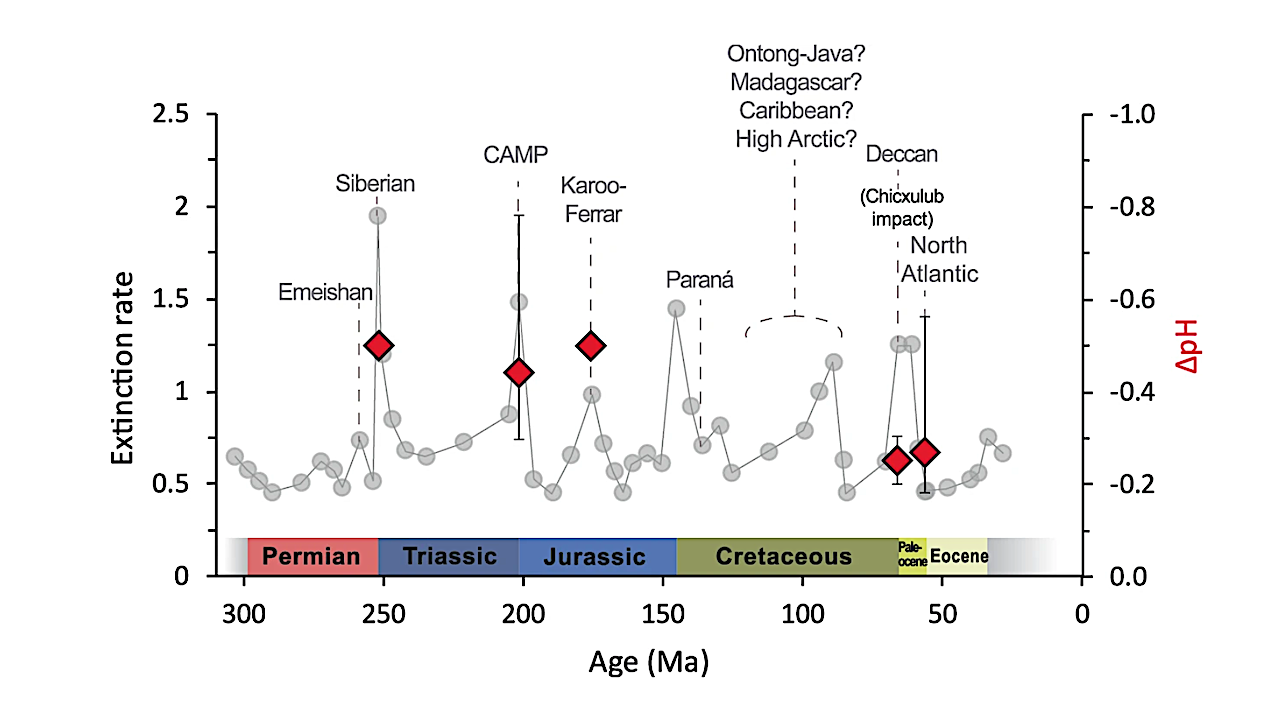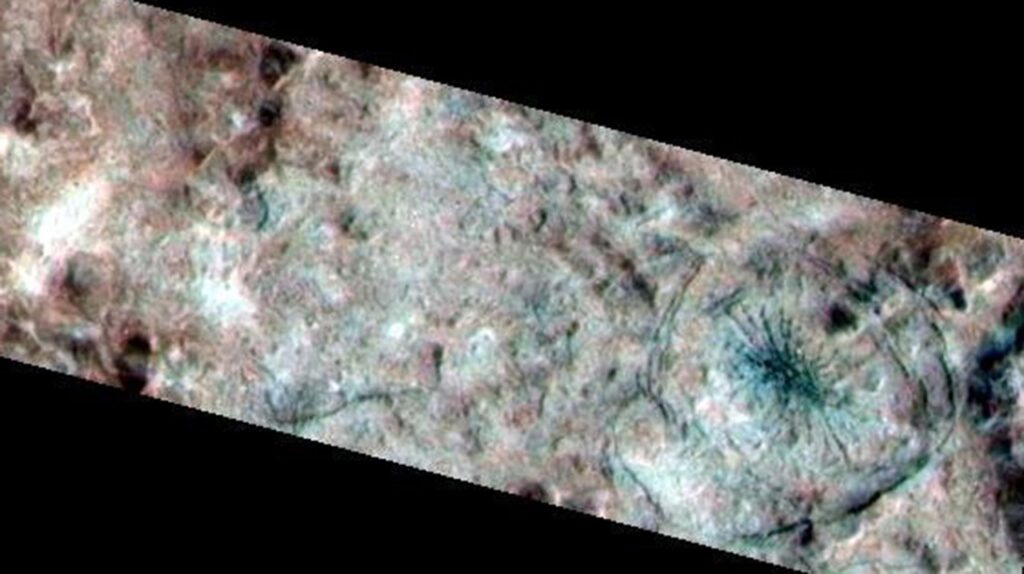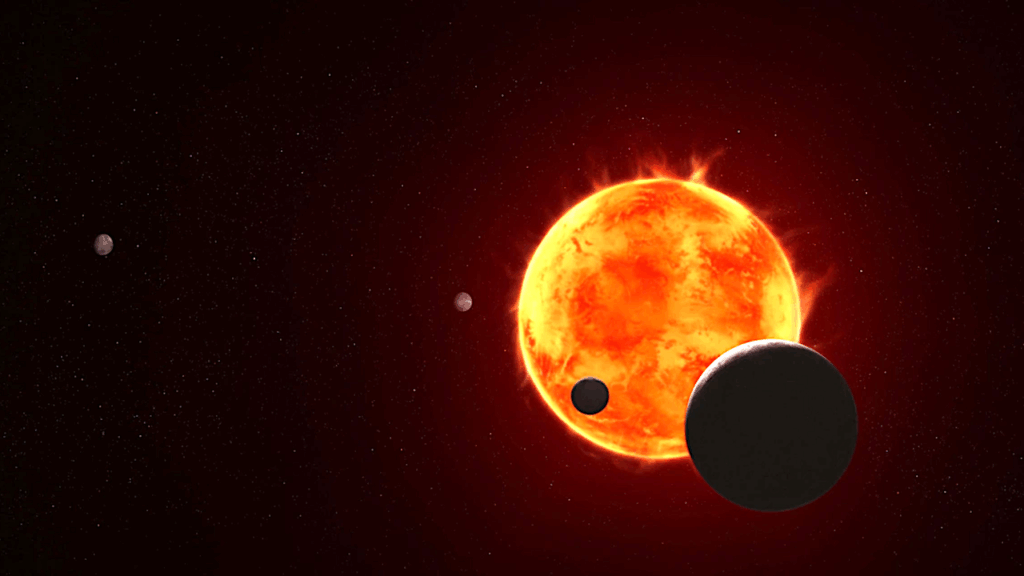Now Reading: Fossilized Oysters Hold The Key To Mass Extinction
-
01
Fossilized Oysters Hold The Key To Mass Extinction
Fossilized Oysters Hold The Key To Mass Extinction


Marine invertebrate extinction rate (grey circles) and the large igneous provinces which correlate with major extinction events (labelled, after Clapham and Renne78). — Nature Communications
In the first and only reconstruction of ocean pH ever carried out, new research from the University of St Andrews and the University of Birmingham has discovered that a rapid acidification of oceans, due to a massive and sudden rise in atmospheric CO2, caused a mass extinction event 201 million years ago.
Published today in Nature Communications it is the first true confirmation that ocean acidification occurred at this event.
The event occurred between the Triassic – Jurassic boundary. In the ocean, the first modern corals had recently evolved as had the plesiosaurs. Other marine life included ichthyosaurs, various fish, and molluscs such as ammonites and bivalves.
Coral reefs disappeared leading to a ‘reef gap’ which took hundreds of thousands of years to begin to re-appear in the geological record.
Whilst researchers had long suspected acidification, they were surprised by the sheer scale of the pH drop – the biggest ever recorded in the geological record.
The St Andrews team, in collaboration with the University of Birmingham, studied oyster fossils from this period to piece together the clearest picture yet of how dramatic CO2 change impacted ocean acidification and biodiversity loss.
The researchers found that the rapid rise in CO2 levels were caused by continental scale volcanic activity, thought to be related to the early stages of the supercontinent Pangaea rifting apart. The team was able to chemically ‘fingerprint’ the source of the carbon that caused the acidification, which they found to be predominantly carbon that came from the solid Earth.
Before this event, the ocean pH level was akin to the average pH in the ocean today, which sits at 8.2. However, researchers now believe that the pH drop was at least 0.3 and most likely >0.4 pH units, which is the equivalent of at least a doubling in atmospheric CO2.
For marine life, the scale and pace of change is as important as the pH level itself.
Dr James Rae, Reader in the School of Earth and Environmental Studies and co-author of the study said “the geological record tells us that major CO2 release transforms the face of our planet, acidifying the ocean, and causing mass extinction. We have to act fast to avoid these outcomes in our future”.
These new important findings make a direct and clear link between geologically rapid carbon release, ocean acidification, major ecological disturbance and in this case, mass extinction.
In addition, ocean acidification has now been shown for three of the ‘Big Five’ mass extinctions in Earth’s history. The size of the pH drop is commensurate with worst case expectations for the future ocean, although anthropogenic carbon release is a lot faster.
Dr Sarah Greene, Associate Professor of Palaeoclimates at the University of Birmingham and co-author of the study, said: “The mass extinction event during the Triassic-Jurassic period was over a much longer timeframe, whereas modern ocean acidification is happening at a much quicker rate. This warning from the past should give us fresh cause to step up efforts to reduce human greenhouse gas emissions that could otherwise see acidification reach or exceed levels seen during these mass extinction events.”
Pulses of ocean acidification at the Triassic–Jurassic boundary, Nature Communications (open access)
Astrobiology,
Stay Informed With the Latest & Most Important News
Previous Post
Next Post
-
 012024 in Review: Highlights from NASA in Silicon Valley
012024 in Review: Highlights from NASA in Silicon Valley -
 02Panasonic Leica Summilux DG 15mm f/1.7 ASPH review
02Panasonic Leica Summilux DG 15mm f/1.7 ASPH review -
 03How New NASA, India Earth Satellite NISAR Will See Earth
03How New NASA, India Earth Satellite NISAR Will See Earth -
 04And Thus Begins A New Year For Life On Earth
04And Thus Begins A New Year For Life On Earth -
 05Astronomy Activation Ambassadors: A New Era
05Astronomy Activation Ambassadors: A New Era -
06SpaceX launch surge helps set new global launch record in 2024
-
 07From Polymerization-Enabled Folding and Assembly to Chemical Evolution: Key Processes for Emergence of Functional Polymers in the Origin of Life
07From Polymerization-Enabled Folding and Assembly to Chemical Evolution: Key Processes for Emergence of Functional Polymers in the Origin of Life



















